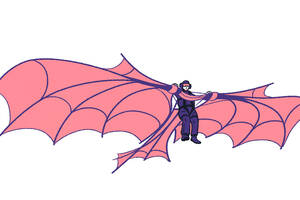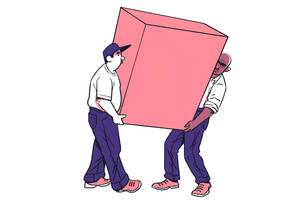Leadership Sep 1, 2011
Downplaying Social Pain
Snubs and rejections hurt worse than others think they do
No one likes to be teased, left out, or left behind. We feel bad for Jenny sitting alone at lunch, for Jimmy picked last every game of kickball, for Ashley taunted about her distinctive lisp, and Alex teased for what seems to be no reason at all.
As bad as we feel for them, however, we do not come close to understanding just how awful Jenny, Jimmy, Ashley, and Alex themselves feel, according to new research by Loran Nordgren, an assistant professor of management and organizations at the Kellogg School of Management. In his study, Nordgren found that there is a difference between how much we think social rejection hurts and how much it does hurts when we actually experience it—a phenomenon known as an empathy gap. In addition, he found that if we do not appreciate how painful bullying is, we do not do as much to punish the bullies and comfort the bullied.
This phenomenon has been playing out in high schools and in headlines across the country, Nordgren says, such as in the cases of gay teenagers who have attempted or committed suicide after being tormented by their peers. “People knew that it was going on, but they didn’t understand how bad it was,” he says, if they themselves were not the target. “They were surprised by the reaction to it. The way I interpret that is they just didn’t understand how distraught the victim was over what was happening.”
A Physical Analog
Earlier work has shown that there is an empathy gap for physical pain. Doctors, for instance, realize their patients are in pain, but have difficulty understanding just how intense and unpleasant that pain is. Patients fall into the empathy gap, too, when they are anticipating how painful their own experiences will be: deciding whether or not to have an elective surgery, say, or undergo a cosmetic procedure. “Women in labor make this mistake all the time,” Nordgren says. “There’s documented evidence that even women who’ve given birth multiple times often think they want a natural childbirth—until they get in full-swing labor and want anesthesia.”
What’s more, headaches and heartaches, break-ups and broken bones have a lot in common psychologically, earlier studies have shown. The same neural pathways involved in physical pain are important in social pain, as well. “To the brain, being rejected looks very similar to skinning your knee,” Nordgren says. Research has even shown that taking painkillers can dull the sting of social pain.
Seeing empathy gaps for physical pain and the similarities between physical and social pain led Nordgren and his colleagues—Geoff MacDonald, an associate professor at the University of Toronto, and Kasia Banas, then a master’s student at VU University Amsterdam—to the idea that an empathy gap might also exist for social pain.
Experiencing social exclusion, the results suggest, makes people more sensitive to the unpleasantness of exclusion, specifically—but not to other aversive experiences.
To investigate the idea, they ran a series of five experiments. In the first experiment, participants were asked to play a computer game known as the Cyberball game, in which they tossed a virtual ball back and forth with what they thought were two other people (in fact, the computer controls the other players). In the inclusion condition, the participant was tossed the ball on one third of the total passes; in the exclusion condition, the other players passed the participant the ball only one tenth of the time. (A group of control participants did not play Cyberball.) Then, each of the participants filled out a questionnaire, ranking how they felt after each of five unpleasant events. Two of the events, learning you were not invited to a party and being rejected after asking someone on a date, involved social exclusion, while the others focused on experiences of disappointment, anger, and fear.
As they had predicted, Nordgren and his colleagues saw that people who had been excluded during the Cyberball game rated the social exclusion situations as being more unpleasant than people in the inclusion and control conditions did, but there were no differences between the groups in how they responded to the situations that induced disappointment, anger, and fear. Experiencing social exclusion, the results suggest, makes people more sensitive to the unpleasantness of exclusion, specifically—but not to other aversive experiences.
While not being passed to much may seem, from the outside, like a minor event, it is anything but to the person being excluded. “As anyone who’s had to manage a lot of people can tell you, human beings are extremely sensitive to fairness and where they stand in the social order,” Nordgren says. When we are excluded, we feel it acutely.
Dealing with Rejection
To rule out the possibility that other unpleasant experiences might also cause people to be more sensitive to social pain, the researchers ran a study identical to the first one—but instead of having a control group, they had a second group of participants play the Cyberball game in the inclusion condition. Once they were finished, however, those participants were told the Cyberball game was in fact a memory and intelligence test, and were asked detailed questions about it—then told they had scored below average. Afterward, these participants ranked the same situations as the others and, like the inclusion group, did not think social exclusion would be as painful as participants who had just been excluded did.
Next, Nordgren and his colleagues looked at how two different parties would respond to an experience of social pain: a person who was excluded and a person who watched someone else be excluded. In this experiment, one participant played the Cyberball game in the exclusion condition—only getting the ball 10 percent of the time—while another participant looked on. Half the observers were told the current player was on their team, while half were told they were on a different team. When the game was over, the participant who had played was asked how much pain they experienced, and the participant who had watched the game was asked how much pain their partner experienced. Observers who thought they were on a different team underestimated how painful the game was for their partner, but observers on the same team did not; statistically, there was no difference between their responses and their partners’. People actively experiencing the pain by identifying with the person being excluded understood how bad it was, while people not experiencing the pain—even while watching someone else be excluded—showed an empathy gap.
The fourth experiment probed whether people show an empathy gap for their own experiences of social pain—whether, looking back, they remember the experience of social exclusion as being less painful than it was at the time. Participants played the Cyberball game and rated their mood immediately after, then a week later were asked to rate what their mood had been immediately after playing the game. People who had been included in the game accurately remembered their mood after playing it; people who had been excluded, however, said a week later that their mood after playing the game was significantly better than it actually was. Even our own experiences of social pain, Nordgren and his colleagues found, seem less bad when we are not currently feeling that pain.
Since most experiences of social pain take place outside the lab, for their final study, Nordgren and his colleagues worked with middle school teachers, who are often tasked both with punishing the bullies and helping the bullied. The teachers played the Cyberball game, during which they were either included or excluded by the other players. They then read a short anecdote about one student, Roger, bullying another student, Anna, and were asked to rate how painful the bullying was for Anna. Next, the teachers were asked to rate how severely Roger should be punished, and how much support Anna and other bullied students should receive from the school. Sure enough, teachers who had been excluded themselves rated the bullying as more unpleasant for Anna. Furthermore, they thought that Anna and other targets of bullying should receive more school support, and that Roger and his ilk should be punished more harshly.
How We View It
“Our beliefs about the severity of social pain dictate how we respond to both the victims, those people who are experiencing the pain, and the abusers, those people who are producing it,” Nordgren says. He and his colleagues are now working on similar studies in the workplace, testing how their findings apply not only to school bullies but to cruel colleagues. This empathy gap could also affect how companies accommodate people experiencing other kinds of social pain, such as in deciding their policies for bereavement leave.
The measures that narrow the empathy gap in the lab are not a panacea for the real world, Nordgren points out. “I don’t think the answer is that we should all induce social pain,” he says. “There’s no really easy cure for this type of psychological bias. I think knowledge of it, though, helps.” When people are aware of their own tendency to downplay others’ pain—to think, as you unwrap your sandwich surrounded by friends, that Jenny alone at her table does not feel all that bad—they can take steps to correct that bias. “As a parent, for example, or a physician, or a school administrator, just knowing that these experiences are worse than they seem to you can inform your judgment,” Nordgren says.
Related reading on Kellogg Insight
A Widespread Stigma: Why are people with mental illness judged unfairly?
The Downside of Deliberating: Why you may not want to think it over
Beware the Siren’s Song: Maintain self-control by avoiding temptation
Nordgren, Loran F., Kasia Banas, and Geoff MacDonald. 2011. “Empathy Gaps for Social Pain: Why People Underestimate the Pain of Social Suffering.” Journal of Personality and Social Psychology.100: 120-128.


